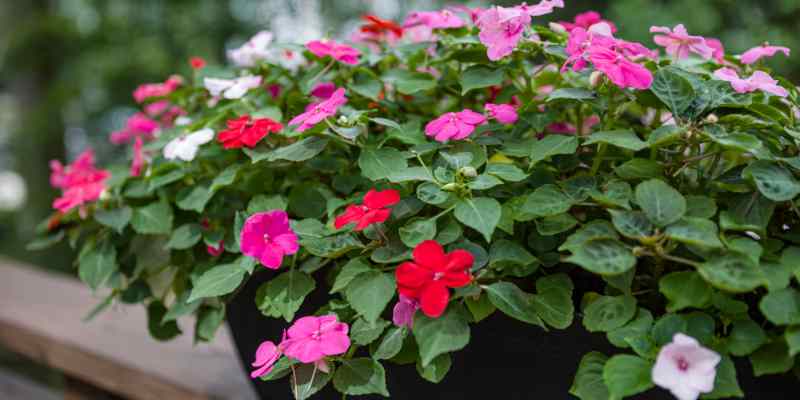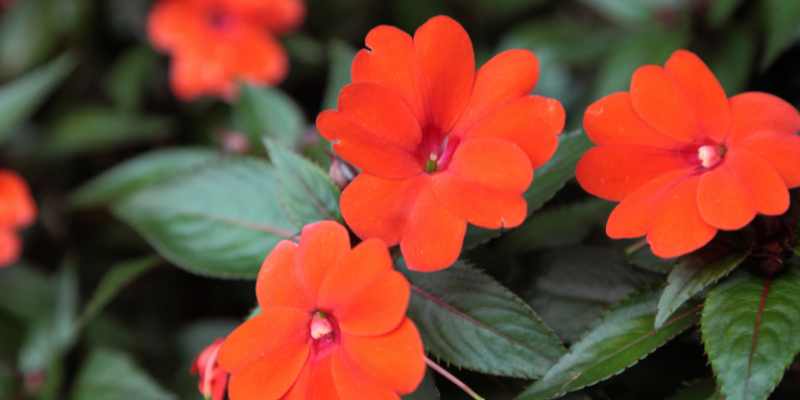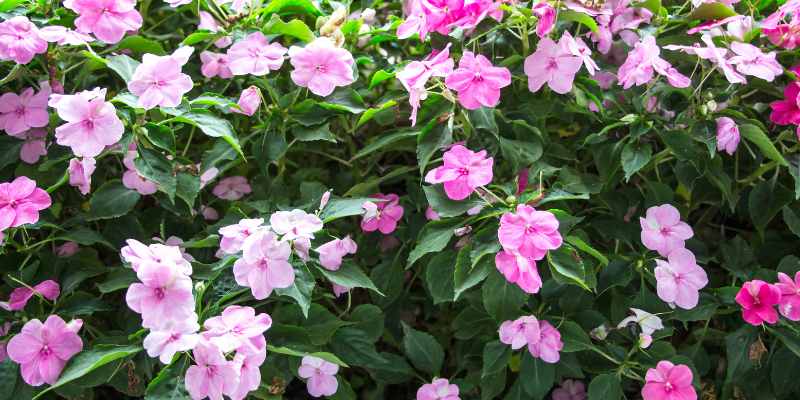Impatiens, often called balsam or busy lizzie, is a very floriferous annual plant prized for its vibrant colours and abundant flowering throughout summer. Its shimmering flowers, ranging from white to deep pink, and including red, orange, purple and salmon, beautifully adorn gardens, borders, beds, rockeries, as well as window boxes and pots. This plant, native to East Africa, is especially valued for its ability to thrive in shady or semi-shady areas where few other plants flower so well. Propagation by sowing is reputedly delicate because it requires warm sowing. Following our advice, you will surely succeed with this pretty flower!

Which impatiens variety to choose?
Impatiens walleriana, or New Guinea impatiens (also called Sultan impatiens), is the most widespread and popular variety with its large flowers 2 to 4 cm in diameter, foliage often tinged with bronze or variegated, and more substantial habit. It offers a wide range of bright colours and generous flowering from late spring until the first frosts. It is ideal for shady or semi-shady locations.
Impatiens balfourii, with its delicate pale pink and white flowers, is another interesting variety. It has the advantage of self-seeding from one year to the next (without being invasive like Impatiens glandulifera), making it very easy to maintain.
Finally, Impatiens hawkeri is resistant to powdery mildew, a fungus that can affect New Guinea impatiens. It also offers a wide choice of bright colours.

When to sow impatiens?
Sowing impatiens is usually done in late winter or early spring, generally between February and March, depending on the climate of your region. It is important to note that these plants are very sensitive to cold. Therefore wait until all risk of frost has passed before planting them outdoors.
Where to sow impatiens?
Impatiens prefer shady or semi-shady areas. They can be sown outdoors in your garden provided there is sufficient shade. Morning sun suits them well. A well-drained soil rich in organic matter is preferable for good growth. Planted at the foot of a tree or in woodland, they brighten shaded areas with their warm colours; in beds they also enliven shady spaces for a long time when used as a border.
If you do not have a garden, you can also sow impatiens in pots or window boxes. They are perfect for brightening a balcony or shaded terrace.
How to sow impatiens?
Impatiens are mostly sown in warm conditions:
- Fill a sowing tray such as a seed tray or, failing that, individual pots with a seed compost or with a mixture of sieved sand + leaf mould + seed compost/heather soil.
- Sow the seeds on the surface, without covering them or barely so, as they need plenty of light to germinate.
- Firm lightly and water gently with a spray to avoid dislodging the seeds.
- Then place your sowing tray or pots in a warm spot (around 20 to 24°C), bright but without direct sun, such as a heated greenhouse or indoors near a window. Plastic film or the tray lid will create a greenhouse effect that favours germination.
- Keep the substrate always slightly moist, but avoid excess water.
Germination of impatiens takes between 10 and 20 days - After 4 to 5 weeks, when seedlings have developed two pairs of true leaves, prick them out into individual pots or buckets containing multipurpose compost.
- Pinch out the tips of well-formed shoots to encourage branching
- Harden off the plants by gradually putting them outside for a few hours a day
- Plant out in open ground or into an attractive planter during May, about 30 cm apart.
- Ideally, add compost or special geranium compost into the planting hole.
You can also sow them directly outdoors: do so in May, again without burying the seeds. Firm and water with a fine spray. In this case, thin out the plants, keeping only one plant every 30 cm.

Required equipment
To sow your impatiens, you will need:
- Impatiens seeds
- A sowing tray (seed tray) or small pots (or a heated mini propagator)
- buckets
- A seed compost
- A spray mister
- Plastic film or a lid for the sowing tray
- Larger pots and multipurpose compost for pricking out
- A warm bright place for germination.
Find out more...
Discover our range of Impatiens seeds
→ Note: Several impatiens varieties result from cross-breeding and hybridization to improve disease resistance or to create new flower colours. Among these hybrids, some are sterile, meaning they do not produce viable seeds. This is notably the case for some varieties of Impatiens hawkeri, marketed under the name New Guinea impatiens.
The Impatiens 'Sunpatiens', for example, is a hybrid variety of Impatiens hawkeri that is sterile. It was specifically bred to be resistant to powdery mildew, a fungal disease that caused serious problems in impatiens crops. 'Sunpatiens' offers a wide range of colours, abundant flowering and strong resistance to heat and humidity.
It is important to note that sterile impatiens must be propagated by propagation by cuttings and not by sowing, because their seeds are not viable.
































Comments